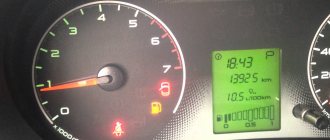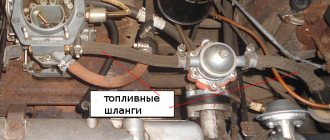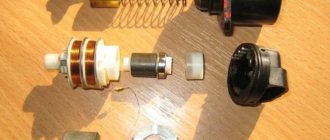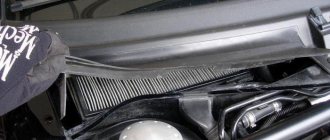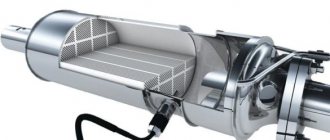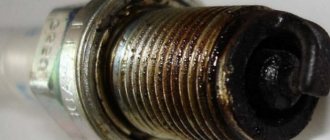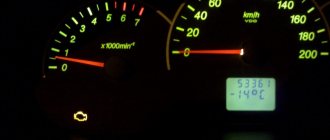Problems with cars are always unpleasant, and when the 8-valve engine on a Kalina, which has not yet driven 50,000 kilometers, fails, it is also insulting. But this problem does not appear immediately, but only when the engine warms up a little. Then the “engine malfunction” light starts flashing.
Turning off the ignition and restarting the car immediately solves the problem. Or rather, it stops for a minute, but then the games with nerves begin again.
The 8-valve engine on Kalina troubles only after the engine has slightly warmed up. In the very first minutes of starting, there is no such feeling: the power unit runs smoothly, the speed is kept at the same level. However, later the tachometer needle begins to twitch, rattling begins, and the engine itself begins to throttle and choke on fuel.
Finding the cause of the malfunction
The engine starts to stall when the fuel pump malfunctions and does not pump in the required amount of fuel, or when it does not burn completely. The substrate of the first case is not only the fuel pump itself, but also the conductive system. And the second reason may be related to problems with the ignition system, spark plug carbon, or improper operation of the engine valves.
If the fuel system is not working properly
, the feeling that the engine is stalling will develop a minute after the start, and then will only increase. If there is a narrowing of the pipeline, or there is no power to the fuel pump, such problems are not uncommon. You can check this after exposing the relay: start the engine, check the functionality of the pump and relay. In this case, the on-board computer will not show errors.
If there is a problem in the valve apparatus itself, in the spark plugs or in the ignition system, it will also manifest itself. Namely: the engine will start normally, but a moment later it will start to stall. Similarly, the power unit fault light should light up, because standard sensors perceive an excess (or lack) of fuel.
When such interruptions in the fuel supply occur, twitching develops, because the amount of gases produced in different engine operating cycles varies.
The engine is tripping: what is it?
Many people have heard the expression “move troit,” but not everyone always understood what it meant. Kalina’s engine has 4 cylinders, when one of them refuses to work, it turns out that the engine starts working on only 3 cylinders, hence the expression that the internal combustion engine is tripled, that is, it works on 3 out of 4 cylinders.
If there are 6 cylinders in a car and one of them does not work, then it turns out that the engine is “triple”, but no one uses this expression, since many even when one of the cylinders fails in a 6-cylinder internal combustion engine they say that it is “triple” .
Problems with valves on Lada Kalina
On the 8-valve Lada Kalina engine, the valves are less reliable than on the 16-valve version. This is a design flaw of engineers that car enthusiasts will have to deal with.
For diagnostics, you will need to at least look at the electronic control unit and compression in the cylinders. This will have to be done at a car service center, where computer diagnostics will initially be offered (see the article “What is included in engine diagnostics”).
Often, there is no result that can be relied upon to fix the problem, because the source of the breakdown is not in the sensors, but in the mechanical part of the car. Therefore, you will have to measure the compression in the cylinders. If it is normal, you need to remove the engine valve cover and inspect the gap between the valves. Its normal value is 0,2-0,35
.
It is important to set the valve clearance in this range, after which the engine stops running and the “engine malfunction” light goes out. By the way, valve adjustment for Kalina is required every 60,000-70,000 kilometers. But when gas is used as fuel, they need to be adjusted more often - every 20,000-30,000 km.
Similar problems
Other problems may also occur besides those described above. When the 8-valve engine on Kalina fails, the culprit of the problem may also be the ECU, which in this model is placed very poorly. If the owner did not wrap it with film, the contacts could oxidize, and conductivity through them could slow down or disappear altogether. The on-board computer will say the same, producing various errors.
Occasionally, it happens that antifreeze gradually seeps into the electronic control unit through a bunch of wires. Moreover, outwardly the ECU will look dry, although aggressive liquid gradually gets inside it. Therefore, the driver needs to open the block housing and inspect the contacts.
Causes of tripping at idle
Engine problems when idling
When you turn on the ignition and start the car, it idles intermittently. There may be several reasons for this . Let's consider the main problems that lead to this effect:
- Problems with spark plugs.
Diagram of possible spark plug faults
All these reasons can cause the engine to idle intermittently.
Trouble-shooting
The causes of the malfunction have been identified, and you can proceed to repair the car. To do this, it is worth checking step by step all the elements that could cause such an effect. So, let's look at the sequence of actions to troubleshoot the problem.
Spark plug
A breakdown, contamination or failure of this element can lead to the car idling intermittently, or, in popular parlance, “triple”. To eliminate the problem, you need to unscrew the spark plugs. How to do it:
- Remove the negative terminal from the battery.
Removing the battery terminal
We take out the high-voltage wires
Removing spark plugs using a 21 socket
That's basically all the dismantling operations.
In order to understand the condition of the spark plug, you need to visually inspect it: if it is too dirty, it means that they are being filled with gasoline and it cannot detonate normally, but if it is too clean, then not enough fuel gets into the engine.
Also, it is imperative to check the performance of the spark plugs. This is done on a spark plug stand, but if there is no such thing, then the old fashioned way, using a tester, we measure the resistance. It is imperative to measure the spark plug gap using a feeler gauge with a mark of 0.10 - this is the standard size that should be on all elements.
High voltage wires
The serviceability of high-voltage wires is checked by checking the resistance. Using a tester, each wire is “ringed” separately, where the value should be 5 ohms.
Checking high voltage wires
Ignition coil
If this unit fails or malfunctions, the effect of poor performance may occur not only at idle, but also when driving. It is worth checking the performance of the coil and replacing it if necessary.
Fuel system
The most common problems with engine rough idling occur in the fuel system. There may be several reasons for this, namely:
Checking and cleaning injectors yourself
Fuel pump filter clogged
It is worth checking all these elements for normal operation. If necessary, troubleshoot any problems that may arise.
How to determine which cylinder is not working
To determine a non-functioning cylinder on a Lada Kalina, you can use two methods: computer diagnostics or hearing.
To determine a non-functioning cylinder using diagnostics, you need to connect a special scanner to the OBD connector and read readings from the operation of the internal combustion engine.
You can also determine a faulty cylinder by the sound of the engine; to do this, you need to remove the connectors from the ignition coils one by one and listen to the engine. For example, when the engine is revving, you need to remove the connector from the first ignition coil; if the engine speed starts to drop or the sound of the engine changes, then this cylinder is working, put the connector back in place and remove it from the second coil, and so on until, when removing the connector from ignition coils, the operation of the engine will not change, this will mean that this particular cylinder is not working at the moment.
Diagnostic methods
When you find out that the motor is not working, you should diagnose it. This is the only way you can find out which cylinder failed and why. You can do this yourself, or go to a car service center. There the engine will be checked using a computer. However, most often you will be able to find out on your own why the engine is tripping. However, if there is a cylinder failure, and the reason is a decrease in compression, you should find a competent specialist who will solve your problem.
Act one. We find the cylinder that failed. To do this, we diagnose the engine after it starts. Be extremely careful when performing this work. Turn the ignition key, the hood should be open. Let's listen to the sounds coming from the engine compartment
Pay attention to how the engine works. Now, one by one, we disconnect the explosive wires that go to the spark plugs.
If you disable a cylinder that is working properly, the engine will run rough. If a cylinder fails after the spark plug is disconnected, the power unit will operate without changes.
How else can you perform diagnostics? We do not touch the explosive wires. We simply turn off the chips one by one that control the fuel supply from the injectors to the cylinders. If you disconnect the chip, but the motor runs without changes, it means that this cylinder has failed.
Act two. We carry out diagnostics of explosive wires, as well as spark plugs. First of all, you should disconnect the wire and carry out an inspection. Is the insulation damaged? This indicates that the problem is in the BB wire. Then we check whether the conductive core is intact. Did you find that it has kinks or is burnt out? This means that a breakdown or internal resistance may occur. To measure it, use a multimeter. The data obtained must satisfy the acceptable readings. Otherwise, current will not flow normally to the spark plug.
Did you find out that everything is fine with the wire? Then we unscrew and diagnose the spark plug.
Is the spark plug base or its electrodes deformed or do they have carbon deposits on them? A new spark plug needs to be installed. If everything is fine with it, then the reason for the engine tripping is not a cylinder failure.
Act three. We determine how much air penetrates the cylinder. If it is not enough, then the fuel mixture will be over-rich, which means the engine will start to stall. The air supply system must not be depressurized. To check whether this is so, you should shut off the intake pipe, and then use a compressor to supply air into the cylinder through a vacuum hose. Supply pressure 0.5–0.7 atmospheres
Pay attention to the sounds you hear when doing this. Is there a hissing sound? This indicates that the air supply system is leaking.
How else can you diagnose the engine for breakdowns? Examine the air filter. When it becomes clogged, no air can enter the cylinder. We inspect the throttle sensor, as well as the mass air supply sensor. To carry out such diagnostics, you will need a computer; it should be connected to a special connector.
Act four. We find out what volume of the fuel mixture enters the cylinder. For this purpose, you will need to measure the pressure in the fuel system (no more than 7 atmospheres). Use a pressure gauge. It must be connected to the injector ramp. To find out the pressure, you will need to measure it in four different operating modes of the engine: when you turn on the ignition, then at idle speed, at operating speed, when the tube is removed from the pressure regulator and the check valve tube is pinched.
Have you discovered that your blood pressure is insufficient? Most likely, the fuel pump or pressure valve in the fuel system has broken down. Is the pressure normal? Then, perhaps, the injectors are faulty or dirt has accumulated in them. At the end of the test, we diagnose the functioning of the fuel system using special equipment. Most likely, you will find errors in the electronic control unit.
Act five. Using a compression meter, we find out what the compression is in the cylinder. This device should be inserted into the spark plug hole of the cylinder that has failed. Then turn the ignition key and increase engine speed. Record the received data 2-3 times. Did you notice that the compression decreased by 15%? This means that the piston in the cylinder has become unusable. The problem may also be in the piston rings or valves. To determine the cause, you will need to disassemble the motor.
Conclusion
The reasons why the Check Lada Kalina warning light may come on, as well as the occurrence of engine tripping, are quite simple. You only need to know the design of the power unit, as well as the operating principle of its systems and components. It is not always possible to fix malfunctions on your own, so in case of failure, it is recommended to contact a car service center.
Many car owners are faced with an unpleasant problem: the engine stalls after washing. This article is devoted to how to safely achieve cleanliness of the engine compartment and what to do if a problem does arise.
Washing the engine compartment of a car means caring not only about its cleanliness, but also about its technical condition. Dust and dirt from the roads constantly gets into the engine compartment
In addition, engine oil and other operating fluids get onto the engine, either due to carelessness when filling, or through deteriorated gaskets. All this mixes, forming a fur coat that prevents the cooling of the power unit, and does not look very attractive
As a rule, it is the latter that pushes drivers to thoroughly wash the engine compartment and get rid of excess dirt.
Peculiarities
As a rule, stable activation of the check sensor occurs suddenly. During normal operation of all units controlled by this system, the indicator lights up briefly when the engine starts, and then goes out. Prolonged illumination indicates certain problems that are quite difficult to identify on your own. Why the check light is on on Kalina 8 and 16 valves is best to find out from specialists at a service station. This is especially true if the presented DIY troubleshooting methods did not produce results.
Hello, dear car enthusiasts! Probably many of you, while driving your car, have been spoiled a lot by the Check Engine light that lights up, then goes out, or even burns (without any obvious reason) with an “eternal flame.”
What's wrong? Even many auto gurus cannot give an exact answer to the question why the injector light is on. Let's try to dig into the structural principle of the malfunction.
The electronic control unit (ECU) of your car controls the engine through a system of sensors. If the injector light comes on, this means that one or more sensor parameters have failed, to which the ECU reacts accordingly.
Let's consider the functions assigned to the injector sensors. Knowing what the sensors are responsible for, it is somewhat easier to judge the behavior of your car and draw conclusions: either fix the problem yourself, or contact a car service for diagnostics.
The injector light is on: what the sensors say
Crankshaft sensor - determines the speed of its rotation, position, and, consequently, the location of the pistons in the cylinder. The sensor operates based on electromagnetic induction.
If the injector is on because the crankshaft sensor is triggered, the consequences, if ignored, may be as follows: engine idling will be unstable, and if the sensor fails, the engine may stall and will not start at all.
The injector light is on due to data from the phase sensor, which is responsible for monitoring the gas distribution control in each engine cylinder. In this case, the ECU switches from phase injection to backup - the so-called pair-parallel mode.
The operating principle of the sensor is based on the Hall effect; the sensor is located on the front of the block on the input manifold side. Typical signs of a malfunction are increased fuel consumption and hesitant engine starting.
Elimination methods
To eliminate the tripping effect on a vehicle, you need to have enough time, since it may take a whole day, as well as tools. To work, you will need a set of wrenches, screwdrivers and heads, as well as a multimeter. So, let's look at how to troubleshoot problems that have arisen.
The on-board computer recognizes a poor-quality mixture by the combustion process. But that's not the worst thing. Poor quality gasoline can clog elements throughout the system. The consequence of long-term use of this type of fluid can lead to the valve mechanism, as well as the pistons, burning out. In this case, major repairs become inevitable, since parts wear out at an accelerated rate.
If it is discovered that the gasoline is of poor quality, the motorist will face a whole range of repair operations, namely:
- Cleaning the fuel tank and replacing the filter.
- Cleaning or changing spark plugs.
- Dismantling and checking injectors.
- And finally, disassembling the cylinder head.
After cleaning, you need to fill it with high-quality gasoline and drive it. The CHECK icon should turn off on its own when high-quality fuel enters the system.
Faulty spark plug
An accompanying symptom that confirms the hypothesis that the cause is the spark plug is the fact that a cold engine trots more strongly. After warming up, the problem often disappears or becomes less pronounced.
First of all, you should pay attention to the color of the central electrode insulator. Determining a normally working spark plug is not difficult. A normal insulator is light or slightly brownish. If the color of the insulator is different from normal, then you need to find out why. Traces of oil or carbon deposits on the insulator indicate that an over-enriched mixture is entering the cylinder, which floods the spark plug, or it is “filled” with oil. As a result, normal sparking is disrupted.
The reasons for this may be different:
- the engine idles a lot when warming up;
- the check valve of the power supply system is faulty;
- low compression in the cylinder;
- impaired valve timing;
- malfunctions in the operation of injectors;
- failure of the oxygen sensor.
After the insulator, you should inspect the spark plug body. It must be intact, without chips or cracks. Particular attention should be paid to the presence or absence of vertical black stripes and black dots. If they are, the spark plug is broken and needs to be replaced.
Finally, the quality of sparking is checked. Moreover, simply connecting the side electrode to ground is not enough, in this way you can only check the performance of the spark plug. To understand how well the spark plug works, you need to hold it at a distance of one and a half to two centimeters from the ground and turn on the starter.
You can also find videos on the Internet with detailed instructions for checking spark plugs.



